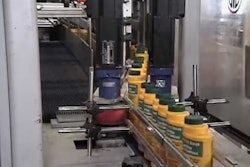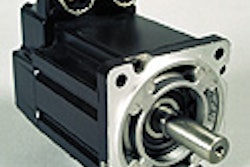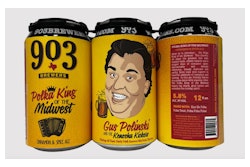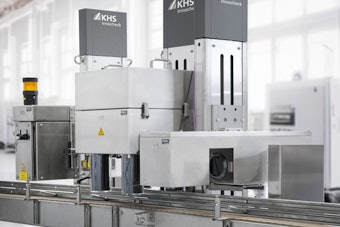
PW speaks with Tom Hernley, packaging systems engineer; Wade Latz, packaging systems engineering manager; and Keith Campbell, director of automation and integration, at the company's Hershey, PA, headquarters.
PW: Can the use of servo technology result in lower equipment prices?
Campbell: Price is more than just the cost of the machine. It can also be how much space a machine takes up. We had one case where we think as a direct result of a good application of servo technology, a vendor came forward with a proposal that took up much less space than the other proposals we had.
Latz: Keith's right. In a recent installation that was designed for eight wrapping legs, one machine builder said they found a way to feed the candy bars into the wrapping machine that takes two meters less space than everyone else, because of the way they can control the positioning of the candy bars. We found that we could fit two more production lines in the building than we thought we could when we built it, all because of this application of technology. The machinery builder approached the design with a fresh start rather than retrofitting 20-year-old designs based on sprockets and chains.
PW: In that case, was the servo machine more expensive, less expensive, or about the same compared to other machines you were evaluating?
Latz: In this particular case, both [machines being evaluated] were servo machines. However, the one that ended up being the better value was designed from the ground up with an understanding of what servos can do, rather than the other one, which was more [a matter of saying] 'Let's just replace gearboxes and chains with servos.'
Campbell: Another thing we're seeing is [that] delivery times of well-designed servo machines are significantly less than delivery times for other technologies.
PW: Hershey has been extremely active in promoting standards for packaging-machine controls within the OMAC organization. Do you still insist that machinery vendors comply with an internal company standard?
Hernley: We try to use the vendor's standard whenever possible to have the external expertise from the vendor. But there are times when we feel our standards are important because of the level of support Hershey needs to provide long term.
Campbell: We need to harmonize the user and the vendor standards to a more common ground.
PW: In other words, a machinery builder has its standard that it uses to crank out a lot of machines efficiently, and then you have your standard.
Hernley: Right, and that's what we don't want to see. As soon as you force something special [from the machine builder], you put yourself in a poor position. When we push a supplier to change to our standards, that delivery can actually be delayed, Plus you're paying a lot of money for these people to come in as experts and help you, and they may spend a day trying to familiarizing themselves with what's there before they can even begin helping you fix your problem.
Latz: Plus we source equipment globally. So if all these local suppliers in Germany, Italy, France, Switzerland, and Brazil are free to use whatever suits their local economics--and particular employees' skills--we might get a good price on a spot basis; but long term, it just becomes chaotic in terms of trying to support all this variability. We were in this position about fifteen years ago, and that triggered a whole series of standardization activities that allowed one of our main plants to remain viably operational for the next several decades.
Hernley: Without making standards brand-specific, the same basic controls standards would enable you to cross over brands. It saves a lot of discussion when we're trying to buy these major packaging systems. What happens now is Hershey makes concessions, the vendors make concessions, and we try to come up with the best possible systems, and it's always project-specific. As these standards emerge globally, a lot of these problems go away.
Campbell: We've seen when we accept vendor black boxes [nonstandard controls whose inner workings are not revealed to the packager] we're practically always sorry down the road somewhere. You get to a point where they always come back and say, 'Well, I can't support that anymore.'
Latz: Also, we try and buy not just machines but systems. In the marketplace right now, there are fewer and fewer companies that are capable of providing the entire system, so the trend is for the major systems suppliers to subcontract out more and more of the components [of that line]. So if we don't standardize, that will make the whole situation worse, because major packaging suppliers are going to have difficulties standardizing in their own product line--which just compounds our problem here.
Hernley: One of the traps that I think we've fallen into here in the past is focusing on putting together a packaging line that works well as a system versus one that's modular. If you're going to use a line for the next thirty years exactly as it was designed, you're fine. But if you want to modify it or take pieces of it away due to changes in the business climate, it becomes very difficult [without standardized components on the machines].
PW: How would you rate machinery builders today in terms of embracing open architecture and producing from-the-ground-up machine designs with intelligent use of servo technology?
Latz: There are a couple ways to answer that question. We're sitting here in central Pennsylvania. What to us might be an international standard might not be an international standard to a small company in rural Italy manufacturing machinery. What to us is proprietary may not be viewed as proprietary in their mind. All that's got to be worked through. But in general I think there are some progressive-thinking companies who have taken advantage of some of this industry standardization with motion control, logic control, and operator interface. They've been able to modify their product line so that it can be both scalable and less expensive, depending on your specific needs. There are some pockets of packaging, wrapping, and cartoning technology that are a lot further behind than other areas. But cartoning is an example where there are some standout companies that have endorsed this technology, which has resulted in positive benefits in their own business as a result.
PW:Why is it so important that machine builders understand controls themselves versus relying on a controls supplier for electronics expertise?
Campbell: I think there's a belief out there that if you buy certain kinds of controls for these machines that the local controls-support people can come in and be a lot of help to you with these machines. But what we said earlier about the importance of understanding packaging, not just programming, makes that belief not really true. (Editor's note: This point was covered in the main article.)
Hernley: When there's a problem with the machine, one that we can't put our fingers on, that's where it's important that we can get the support of the company that makes the packaging machine. Because that's what they are experts at--packaging product.
Latz: When your Ford Taurus breaks down, you don't call TRW for brakes or Bosch because of the ignition system or some outfit in Canada that assembled the engine. You bring it back to the Ford dealer. The Ford dealer understands how the system works. We go back to the equipment supplier because they understand how to package the products, and they understand all the overall system as needed, as well.
Campbell: More often the problems are that I've lost ten points of efficiency on this thing and I don't know why. That's when you need most the help from the machine vendor.
Latz: The machine vendor knows how much of a crease to put in the paperboard tab so the tab bends with a certain amount of pressure, just the right amount. The machine vendor understands how long you can run a belt underneath a stationary piece of chocolate before the chocolate begins to melt. That's the kind of specific know-how that's not the business of controls suppliers.
Campbell: I guess in reality we think there's probably too much focus on the controls and not enough focus on the system and the machine. Everyone's focused on the controls--'We' ve got to buy from this controls supplier because we trust them.' Well, we're not sure that's going to pay off.
Latz: One other point to make is when we buy equipment, we're really buying the capability to manufacture something to a particular set of specifications. In a lot of cases, machinery companies don't want to sell with that level of commitment and accountability. They want to sell you a particular model number per their specification sheet, leaving the onus on you to get it to work to meet your manufacturing requirements. So what we try to do in a lot of cases is purchase from the company who can deliver manufacturing capability rather than a particular piece of equipment.
PW:Can standards keep up with rapid advances in electronic controls?
Hernley: I think why the focus is so much on electronics rather than mechanical is it's evolving so fast. Today, for a given control in our factory, two years from now it's obsolete. How do you [keep up] with all this? Standards and open architecture is one answer. How do you do it at home with your home computer? Every four years you throw it away. Well, we're not going to throw packaging machines away in four years, and you didn't have that with mechanical machine designs. A gear is a gear is a gear.
Campbell: That's a good example, because if you think about how I throw computers away, I throw the computer away a lot more frequently than I throw the monitor away. The reason I can do that is that there's a standard that says the interface between a computer and a monitor is this. So I can have a Dell or IBM or Sanyo or [some other] monitor and I can have a Dell or an IBM or [other] computer and throw one [device] away and keep the other.
Hernley: Sometimes, there's no need to go with the latest and greatest. In packaging, there's always faster processor; there's Windows-this, Windows-that. And I guess the question is, if you are building a system identical to one that's already running, then why make a change? If there's a platform and it works, and you're buying another one next year, why do we need all the newest controls? Why on this job--for flexibility, for modularity, for price, for efficiency--what's it buying me. Everybody looks at you and says, 'Well, it just came out.' [Laughter.]
PW:Do you find controls suppliers reluctant to standardize for fear of losing their differentiation in a crowded marketplace?
Campbell: I think there's some reluctance, but the better we can cooperate as users, the more we can overcome that reluctance. Standards can give the technology supplier the opportunity to demonstrate how they add value. If I have a choice of buying a Dell computer or HP computer, and one of those computers brings me more value, that's the one I'll buy. It's not so much that they're interchangeable and that they all do exactly the same thing. The interfaces between them are common. But any one of those computers may be a better value for a particular application.
Click here to see the remainder of this interview, originally published in the March 2002 issue of Packaging World.
























